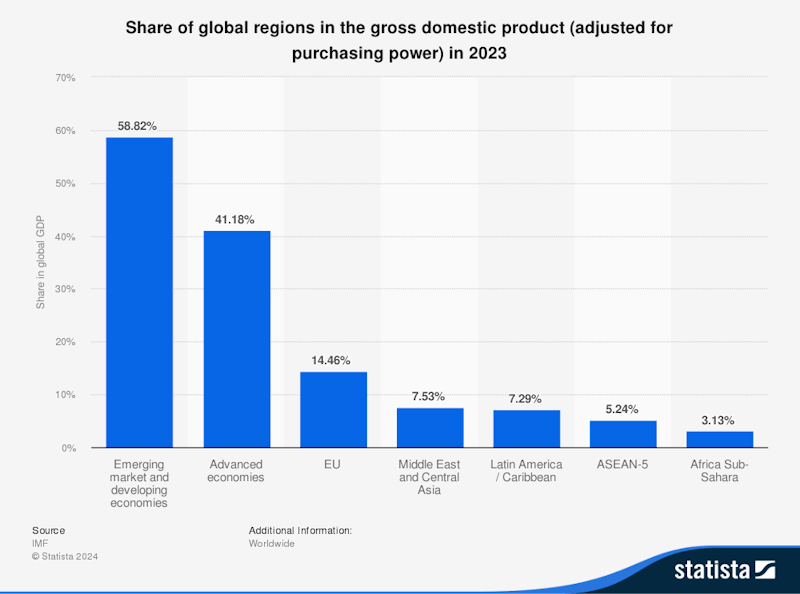Study Notes
What helps explain the rising share of global GDP accruing to emerging and developing countries?
- Level:
- A-Level, IB
- Board:
- AQA, Edexcel, OCR, IB, Eduqas, WJEC, NCFE, Pearson BTEC, CIE
Last updated 24 Oct 2024
The balance of the world economy is changing. emerging and developing countries now have nearly sixty per cent of global GDP. Why are emerging & developing countries seeing their share rise over time?

The rise in the share of global GDP for emerging and developing countries is a significant trend in the world economy. Several factors contribute to this shift:
1. Rapid Economic Growth in Emerging Markets:
Many emerging economies, particularly in Asia, Africa, and Latin America, have experienced rapid economic growth over the past few decades. This is driven by factors such as:
- Industrialization and urbanization: Countries like China and India have undergone significant industrialization, transitioning from agriculture-based economies to manufacturing and services, which has boosted their GDP.
- Rising consumer demand: With increasing incomes and population growth, there has been a surge in domestic consumption in these countries, further driving economic growth.
2. Demographic Factors:
Emerging and developing countries tend to have younger and faster-growing populations compared to advanced economies. A larger working-age population contributes to higher productivity, economic output, and consumer demand, fueling growth in these regions.
3. Globalization and Trade:
Globalization has allowed emerging markets to integrate into the global economy more effectively. These countries benefit from:
- Export-led growth: Many developing countries have positioned themselves as manufacturing hubs, supplying goods to developed nations, especially in sectors like electronics, textiles, and machinery.
- Foreign Direct Investment (FDI): FDI inflows have increased, particularly in countries like China, India, Vietnam, and Brazil, leading to infrastructure development, technology transfer, and job creation.
4. Technological Adoption:
Emerging economies have adopted new technologies at a faster pace, allowing them to leapfrog traditional development stages. The use of mobile technology, e-commerce, and digital banking, for example, has significantly increased productivity and financial inclusion in many developing countries.
5. Structural Reforms and Economic Liberalization:
Many emerging and developing countries have implemented market-oriented reforms, including privatization of state-owned enterprises, deregulation, and trade liberalization, which have made their economies more competitive and attractive for investment.
6. Commodities and Natural Resources:
Several developing countries are rich in natural resources like oil, minerals, and agricultural products. As global demand for these resources has risen, many of these countries have benefited from higher export revenues and investment in resource extraction industries.
7. Improved Governance and Stability:
While challenges remain, many developing nations have made significant strides in political stability, governance, and economic management. Improved macroeconomic policies, lower inflation, and better fiscal management have created a more stable environment for growth.
8. Urbanization and Infrastructure Development:
Rapid urbanization in developing countries has increased productivity, as urban areas tend to be more efficient in terms of labor and resource use. Infrastructure development, particularly in transportation, energy, and telecommunications, has also supported economic expansion.
9. Shift in Global Economic Power:
There is a gradual shift in global economic power from the West to the East, with countries like China and India emerging as dominant players. This has led to a redistribution of global economic influence, with emerging economies playing a more significant role in international institutions and trade.
10. Convergence Theory:
According to the theory of economic convergence, poorer economies tend to grow faster than wealthier ones, as they have the potential to catch up by adopting existing technologies and benefiting from the experiences of more developed countries. This "catch-up" effect is evident in many emerging markets, leading to their rising share of global GDP.
Summary:
The growing share of emerging and developing countries in the global GDP is due to their rapid economic growth, favorable demographics, integration into global trade, technological advancements, and improvements in governance. This shift reflects the broader rebalancing of the global economy, with emerging markets becoming increasingly important drivers of global growth and economic dynamism.
You might also like
Articles on the Chinese Economy
Study Notes

Exposure to the Chinese Economic Slowdown
10th November 2015

OCR F585 Economics - Extract 1 - Globalisation and Trade
5th April 2016

The return of outsider economics
9th September 2016
Chinese Economy Exemplar Student Essay
Practice Exam Questions

Strangest Things - Starter or plenary for lesson on global economics
10th January 2018
A* Evaluation on Foreign Direct Investment
Topic Videos
Daily Email Updates
Subscribe to our daily digest and get the day’s content delivered fresh to your inbox every morning at 7am.
Signup for emails